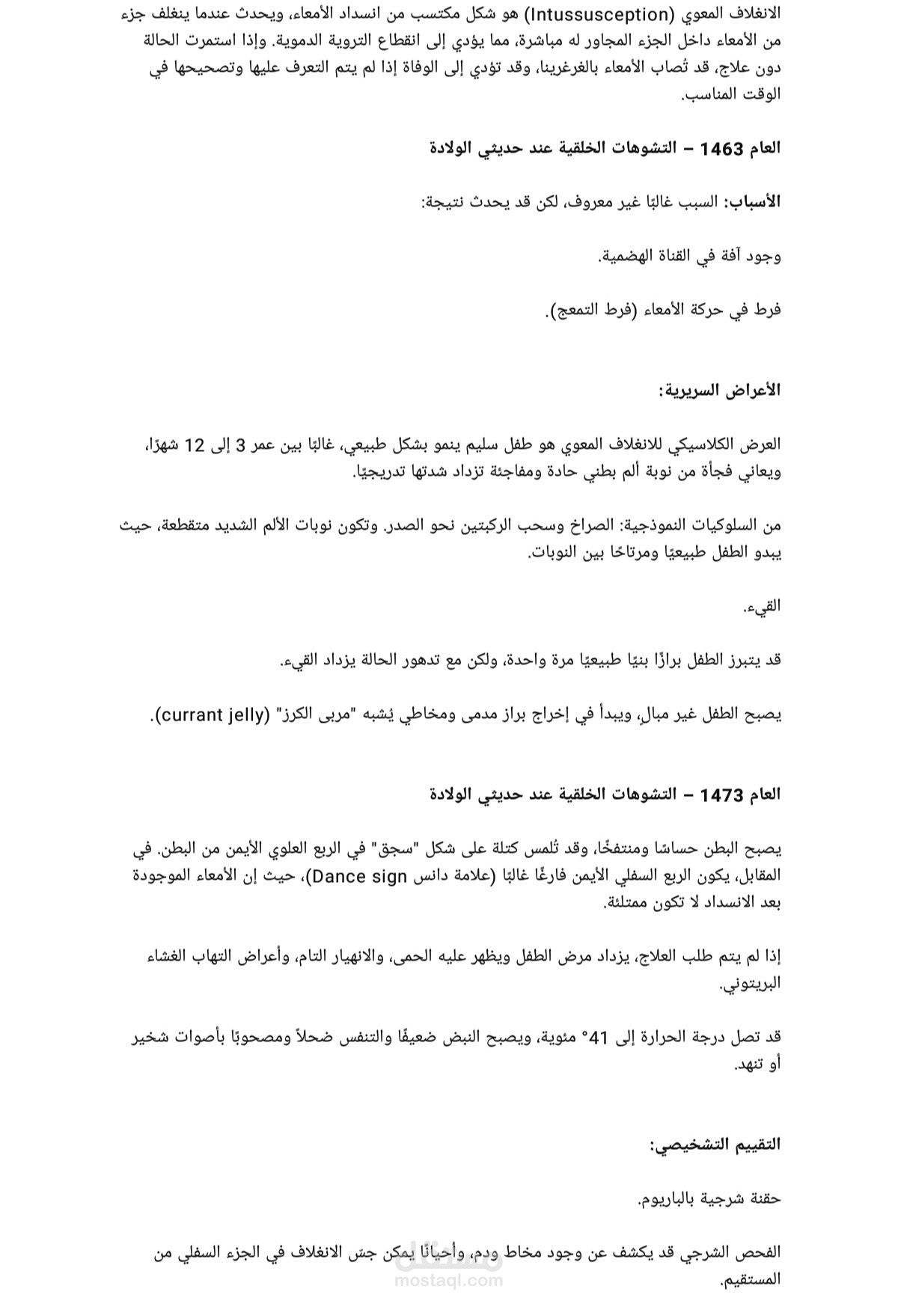ترجمه مقال طبي
تفاصيل العمل
Intussusception is acquired form of intestinal obstruction. It is the invagination of a portion of the bowel into the portion immediately distal to it, thus the blood supply is cut off and if it is condition continuous, the bowel will become gangrenous. Death may result if the condition is not recognized and corrected.
1463rd year
Congenital Anomalies of Newborn
Causes:
The cause is usually unknown. But it may be due to: lesion of intestinal canal, hyper
peristalsis.
Clinical manifestations:
Classic presentation of Intussusception is a healthy, thriving child, usually
between 3 and 12 months of age, who suddenly has an episode of acute
paroxysmal abdominal pain, suddenly has an episode of acute paroxysmal
abdominal pain, sudden abdominal pain which progressively be more sever.
Typical behavior includes screaming and drawing the knees up the chest. These
episodes of severe pain are characterized by the Chest. These episodes of severe
pain are characterized by intervals in which the child appears normal and
comfortable.
Vomiting.
The child passes one normal brown stool. However, as the condition worsens,
the vomiting increases.
The child becomes apathetic, and subsequent stools are red and currant jelly-
like from the passage of stool mixed with blood and mucus.
1473rd year Congenital Anomalies of Newborn
The abdomen becomes tender and distended. A sausage- shaped mass may be felt in the upper right quadrant. In contrast, the lower right quadrant usually feels empty (Dance sign) as the bowel distal to the obstruction is less involved and free of contents. If treatment is not sought, the child becomes acutely ill with fever, prostration, and signs of peritonitis.
Temperature may rise to 41°C. - Pulse becomes weak and respiration become shallow and grunting.
Diagnostic evaluation: - Barium enema. - A rectal examination reveals mucus, blood and occasionally a low intussusception itself.الانغلاف المعوي (Intussusception) هو شكل مكتسب من انسداد الأمعاء، ويحدث عندما ينغلف جزء من الأمعاء داخل الجزء المجاور له مباشرة، مما يؤدي إلى انقطاع التروية الدموية. وإذا استمرت الحالة دون علاج، قد تُصاب الأمعاء بالغرغرينا، وقد تؤدي إلى الوفاة إذا لم يتم التعرف عليها وتصحيحها في الوقت المناسب.
العام 1463 – التشوهات الخلقية عند حديثي الولادة
الأسباب: السبب غالبًا غير معروف، لكن قد يحدث نتيجة:
وجود آفة في القناة الهضمية.
فرط في حركة الأمعاء (فرط التمعج).
الأعراض السريرية:
العرض الكلاسيكي للانغلاف المعوي هو طفل سليم ينمو بشكل طبيعي، غالبًا بين عمر 3 إلى 12 شهرًا، ويعاني فجأة من نوبة ألم بطني حادة ومفاجئة تزداد شدتها تدريجيًا.
من السلوكيات النموذجية: الصراخ وسحب الركبتين نحو الصدر. وتكون نوبات الألم الشديد متقطعة، حيث يبدو الطفل طبيعيًا ومرتاحًا بين النوبات.
القيء.
قد يتبرز الطفل برازًا بنيًا طبيعيًا مرة واحدة، ولكن مع تدهور الحالة يزداد القيء.
يصبح الطفل غير مبالٍ، ويبدأ في إخراج براز مدمى ومخاطي يُشبه "مربى الكرز" (currant jelly).
العام 1473 – التشوهات الخلقية عند حديثي الولادة
يصبح البطن حساسًا ومنتفخًا، وقد تُلمس كتلة على شكل "سجق" في الربع العلوي الأيمن من البطن. في المقابل، يكون الربع السفلي الأيمن فارغًا غالبًا (علامة دانس Dance sign)، حيث إن الأمعاء الموجودة بعد الانسداد لا تكون ممتلئة.
إذا لم يتم طلب العلاج، يزداد مرض الطفل ويظهر عليه الحمى، والانهيار التام، وأعراض التهاب الغشاء البريتوني.
قد تصل درجة الحرارة إلى 41° مئوية، ويصبح النبض ضعيفًا والتنفس ضحلاً ومصحوبًا بأصوات شخير أو تنهد.
التقييم التشخيصي:
حقنة شرجية بالباريوم.
الفحص الشرجي قد يكشف عن وجود مخاط ودم، وأحيانًا يمكن جسّ الانغلاف في الجزء السفلي من المستقيم.
